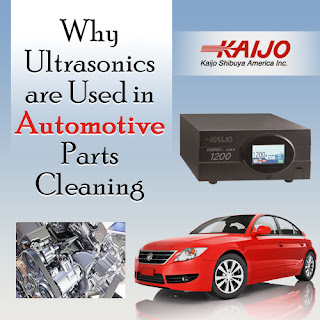Automotive parts are subject to heavy and hard-to-remove oil, grease, and other carbon-related contamination. There are traditional ways of cleaning contaminated automotive parts, such as removing deposits manually as well as, soaking, spraying, brushing, and scraping the parts. These cleaning methods are time-consuming and require the use of chemicals that can damage the part surfaces.
Ultrasonic cleaning systems are the ideal alternative to traditional cleaning methods. Ultrasonic cleaning of the automotive parts is quicker and delivers better cleaning performance. This method involves no scrubbing, prolonged soaking, spraying, scraping, and using harsh cleaning chemicals.
With ultrasonic cleaning, sound waves are generated by ultrasonic transducers immersed in the cleaning solution. The sound waves produce tiny cavitation bubbles that deliver a scrubbing action on the surface of the parts that are being cleaned.
One of the keys to effective and thorough cleaning parts using Ultrasonic cleaning is choosing the right frequency.
1) High ultrasonic frequencies produce smaller bubbles that clean gently, which is ideal for cleaning more delicate equipment such as medical instruments, semiconductor components, and computer parts, most of which have some soft surfaces or structures that require gentle cleaning.
2) Low ultrasonic frequencies produce larger bubbles that do robust cleaning, which is ideal for removing contamination rapidly but can damage surfaces of delicate parts. Therefore, this frequency is ideal for cleaning parts that have hard surfaces, such as automotive parts made of steel. These parts can be exposed to the robust cleaning of low ultrasonic frequencies in the 20 kHz range.
For basic ultrasonic cleaning of automotive parts, an ultrasonic generator powers the ultrasonic transducers that are immersed in a cleaning tank. The contaminated automotive parts are placed in a tank filled with water. The bubbles produced in the cleaning tank by the ultrasonic system dislodge dirt on the part surfaces.
Cleaning automotive parts with heavier and harder-to-remove dirt and contamination (such as hardened oil and grease), can be enhanced by heating the cleaning solution and/or by adding a mild detergent. For automotive cleaning applications, Kaijo can supply ultrasonic cleaning systems that operate at frequencies from 20 kHz range for heavy-duty cleaning, and up to 2 MHz for delicate parts such as sensors or electronics.
Read the complete article, “Why Ultrasonics Are Used in Automotive Parts Cleaning,” for more details on using ultrasonic cleaners for automotive parts. For a free consultation or quote contact Kaijo Shibuya at 408-675-5575 or email info@kaijo-shibuya.com.


No comments:
Post a Comment